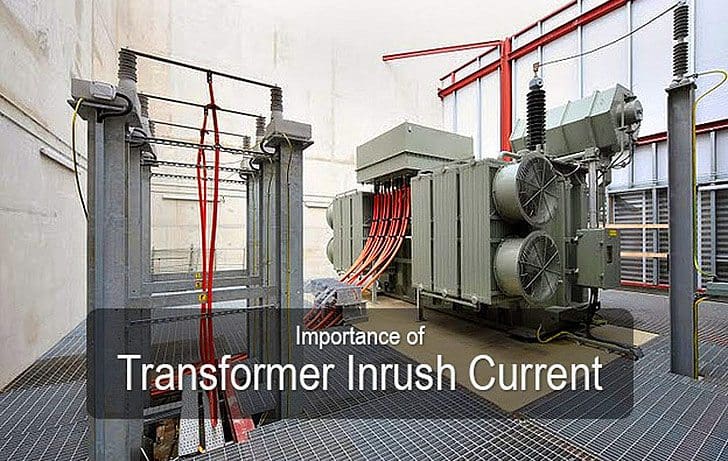Residual Flux
When a transformer is taken off-line, there will be a certain amount of residual flux that can remain in the core due to the properties of the magnetic core material.

The residual flux can be as much as 50 to 90% of the maximum operating flux, depending on the type of core steel. When voltage is reapplied to the transformer, the flux introduced by this source voltage will build upon that which already exists in the core.
In order to maintain this level of flux in the core, which can be well into the saturation range of the core steel, the transformer can draw current well in excess of the transformer’s rated full load current.
Depending on the transformer design, the magnitude of this current inrush can be anywhere from 3.5 to 40 times the rated full load current. The waveform of the inrush current will be similar to a sine wave, but largely skewed towards the positive or negative direction. This inrush current will experience a decay, partially due to transformer losses, which will provide a dampening effect; however, the current can remain well above rated current for many cycles.
Decent approximations of the inrush current require detailed information regarding the transformer design which may be available from the manufacturer but is not typically available to the user.
Actual inrush currents will also depend upon where in the source voltage wave the switching operations occur, the moment of opening effecting the residual flux magnitude, and the moment of closing effecting the new flux.
Resource: James H. Harlow – Harlow Engineering Associates











So for we know net flux in the transformer core is constant(let Q(i don’t have flux symbol here to put,so i used Q),Due to property of core some flux is stay in it(i,e Qr=50%-90%Q).So to maintain flux Q in the core you need 10% of flux from the supply write,so to produce this flux less current write …How it will take high currents?
Question:
We know residual flux exist in the core after energizing the core and this flux (magnetic field) is constant and fixed. According to Faraday’s law we need to have fluctuation magnetic fields to induec voltage on secondary but we don’t. Where that current come from?
Sir, Is it advantageous to numerically calculate the maximum inrush current like ABB , very before the large power transformers installed in the electric power system
I would like to ask one question regarding transformer. My Question is – If supply is interrupted and an inverter is connected at home, immediate in on condition the back supply of inverter or alternator effect the transformer or what is the effect of transformer ?
The residual flux is not the main cause of the transformer inrush current.
Even when there is no residual flux (assuming magnetization curve passes through zero, i.e. no hysteresis) there will be an inrush current. For single phase transformer the worst case is to be turned on when voltage passes through zero. That is because this corresponds to maximum of flux in steady AC condition (lagging 90 degrees). Since flux cannot step from zero to maximum there will be an aperiodic component of it summed up with steady AC one (so that initially the sum is zero or indeed equal to residual flux prior to turn on). In any case when the AC component is at maximum and is the same polarity as aperiodic component their sum will be well over the saturation knee with resulting high magnetization current. The aperiodic component will decay, but that may indeed take many cycles. Consequently, If at turn on the voltage passes through maximum there will be no inrush current.
This is easy to simulate, for example in LT SPICE.
The possible solution to limit the inrush current is to turn on the transformer though resistor(s) then bypass them after short time.
Referring ” In Rush Current Phenomena” What precautions / tests should we carry out as Commissioning Engineer’s once we Switch Off the MV Transformers for Maintenance or any Shutdown request.
Hello Sir. We perform demagnetization process in very simple and efficient way. The device generates the DC current, and changes the polarity of the current in every step. Also the magnitude of the DC current is decreased in every step. In this way the surface of the core hysteresis loop is decreasing and transformer core become demagnetized (minimum residual flux). The process can be easily verified with the excitation current test and the FRA test.
I think that the flux is starting, the ohmical characteristics is most relevant than the induction properties, until the AC voltage does not describe a pair of cycles at which the flow starts to be generated. It´s a pity that In not to take pictures of it handy but mentally as James H says in his commentary, is as much as 40 times the rated current, in the case of connection at the maximum positive or negative value of the sinusoid. In domestic characteristic curve magnetotermico guard has to be special for it (example welding transformers) and power electronics, software control prevents the first ten cycles (50Hz 20ms X 10 = 200ms) than the main breaker is open every time you connect the transforme, ignore this value in that moment . The funny thing is that if by chance, a breaker closes and concrete in the same time of zero crossing of the voltage, the In Rush effect is only less than 2 to 3.5 times the nominal current as he said. My question is if its possible call to this phenomenon like “the core´s inertial flux”.